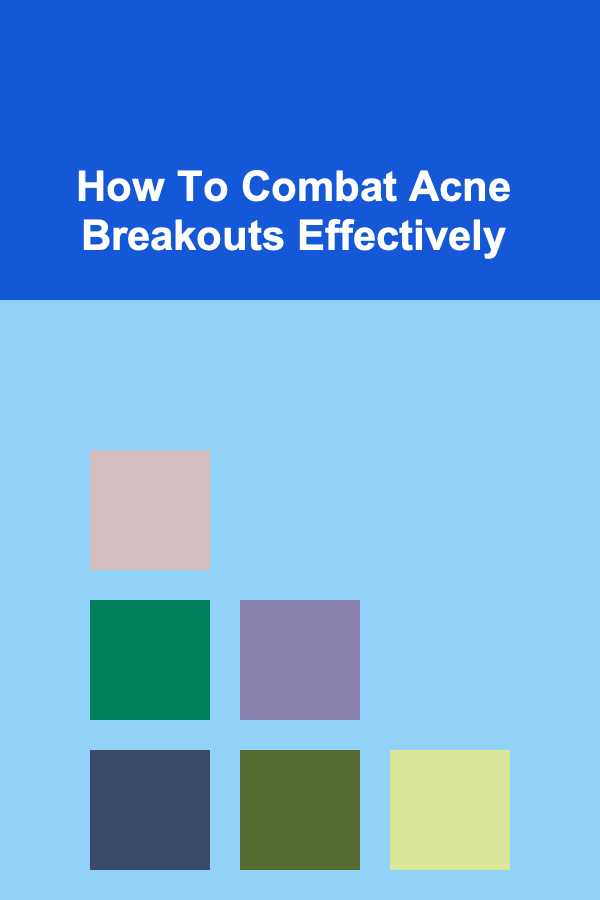
How To Combat Acne Breakouts Effectively
ebook include PDF & Audio bundle (Micro Guide)
$12.99$10.99
Limited Time Offer! Order within the next:

Acne is one of the most common skin conditions in the world, affecting individuals of all ages. Whether you're dealing with occasional pimples, stubborn blackheads, or more severe cystic acne, breakouts can be frustrating and often feel impossible to manage. However, acne is a treatable condition, and with the right approach, you can significantly reduce and manage breakouts.
In this article, we will explore effective strategies to combat acne, covering everything from understanding the causes to practical skincare tips, lifestyle adjustments, and medical treatments that can help you achieve clearer skin. We will also debunk common myths about acne to ensure that the methods you follow are evidence-based and effective.
Understanding Acne Breakouts
To effectively combat acne, it's important first to understand what causes breakouts. Acne occurs when hair follicles become clogged with oil, dead skin cells, and bacteria. This can happen due to various factors, including hormonal changes, stress, genetics, or improper skincare routines.
Here's a breakdown of the primary causes of acne:
1. Excessive Sebum Production
Sebum is the natural oil produced by sebaceous glands in your skin. While sebum helps keep the skin moisturized and protected, excessive sebum production can clog pores, leading to acne. This overproduction of oil is often triggered by hormonal fluctuations, such as during puberty, menstruation, or pregnancy.
2. Clogged Pores
Clogged pores occur when dead skin cells, oil, and debris accumulate inside hair follicles. This provides an environment for bacteria to thrive, leading to inflammation and the formation of pimples, blackheads, or whiteheads.
3. Bacterial Growth
The bacteria Propionibacterium acnes (P. acnes) thrives in the clogged pores, contributing to inflammation and infection. As bacteria multiply within the pores, they can cause acne lesions such as pustules or cysts.
4. Inflammation
Inflammation is the body's natural response to infection or irritation. When your pores become clogged with oil and bacteria, your skin's immune system triggers an inflammatory response, which leads to redness, swelling, and pus-filled pimples.
5. Hormonal Changes
Hormonal imbalances are one of the leading causes of acne breakouts, especially during puberty, menstruation, pregnancy, and in those with polycystic ovary syndrome (PCOS). Hormones, particularly androgens, can cause sebaceous glands to enlarge and produce more sebum, triggering acne.
6. Diet and Lifestyle Factors
While research on the direct link between diet and acne is ongoing, some studies suggest that certain foods may exacerbate acne. Foods high in refined sugars, dairy, or fats may influence sebum production and inflammation. Additionally, stress and lack of sleep can also play a significant role in triggering or worsening acne outbreaks.
Step-by-Step Guide to Combat Acne Effectively
Now that we understand the causes of acne, let's explore practical steps that can help manage and prevent breakouts.
1. Establish a Consistent Skincare Routine
The first line of defense against acne is a good skincare routine. A well-thought-out routine can help cleanse the skin, regulate oil production, and reduce inflammation.
a. Cleansing
Use a gentle, non-comedogenic (non-pore-clogging) cleanser twice a day---once in the morning and once before bed. This helps remove excess oil, dirt, and bacteria without stripping the skin's natural barrier. Avoid harsh scrubs or soaps, as they can irritate the skin and worsen acne.
b. Exfoliation
Exfoliation helps remove dead skin cells that can clog pores. You should exfoliate with gentle, chemical exfoliants like salicylic acid or glycolic acid, which help break down the debris in the pores. Avoid over-exfoliating, as this can cause irritation and inflammation.
c. Toning
Toners can help balance the skin's pH and remove any residual oil or dirt left after cleansing. Look for toners that contain ingredients like witch hazel, salicylic acid, or tea tree oil, which can help reduce oil production and bacteria growth.
d. Moisturizing
Even if you have oily skin, moisturizing is crucial. Skipping this step can actually cause the skin to produce more oil in an attempt to compensate for dryness. Choose a lightweight, oil-free, non-comedogenic moisturizer to keep your skin hydrated and balanced.
e. Spot Treatment
For targeted treatment of active breakouts, use spot treatments containing ingredients like benzoyl peroxide, salicylic acid, or sulfur. These ingredients help reduce inflammation, fight bacteria, and unclog pores.
2. Incorporate Acne-Fighting Ingredients
Several key ingredients can be helpful in managing and preventing acne breakouts. Here's a look at the most common and effective acne-fighting ingredients:
a. Salicylic Acid
Salicylic acid is a beta-hydroxy acid (BHA) that helps exfoliate the skin's surface and penetrate deep into the pores to clear out excess oil and dead skin cells. It is especially effective for blackheads and whiteheads.
b. Benzoyl Peroxide
Benzoyl peroxide is an antibacterial agent that targets the bacteria responsible for acne. It also helps reduce inflammation and prevent new breakouts from forming.
c. Retinoids
Retinoids, including tretinoin, adapalene, and retinaldehyde, are derived from vitamin A. These powerful ingredients promote cell turnover, prevent clogged pores, and reduce the severity of acne. They can also help fade post-acne scars and improve skin texture.
d. Tea Tree Oil
Tea tree oil has natural antibacterial properties and can help reduce inflammation and kill acne-causing bacteria. It is a popular natural alternative to traditional acne treatments.
e. Niacinamide
Niacinamide is a form of vitamin B3 that helps calm inflammation, reduce redness, and regulate oil production. It is especially beneficial for those with sensitive skin.
3. Adopt Healthy Lifestyle Habits
In addition to a consistent skincare routine, certain lifestyle habits can greatly improve your skin's overall health and reduce acne breakouts.
a. Dietary Adjustments
While there is no definitive proof that specific foods cause acne, some individuals may find that their acne worsens with certain dietary triggers. Consider reducing your intake of high-glycemic foods (e.g., sugary snacks, white bread) and dairy products, as they may increase insulin levels and inflammation.
Focus on a well-balanced diet that includes plenty of fruits, vegetables, whole grains, and healthy fats. Omega-3 fatty acids, found in foods like fish and flaxseeds, have anti-inflammatory properties that may help reduce acne flare-ups.
b. Stay Hydrated
Drinking enough water is essential for maintaining healthy skin. Water helps flush out toxins, supports hydration, and promotes overall skin health. Aim for at least eight glasses of water per day, or more if you're physically active.
c. Manage Stress
Stress can exacerbate acne by triggering hormonal changes that increase sebum production. Managing stress through activities like meditation, yoga, deep breathing exercises, or regular physical activity can significantly improve both your mental health and your skin's appearance.
d. Get Enough Sleep
Poor sleep quality can increase cortisol levels, a stress hormone that promotes inflammation and acne. Aim for seven to nine hours of sleep per night to give your skin time to repair itself and maintain a healthy, balanced state.
4. Consider Medical Treatments
If your acne persists despite home treatments, it may be time to seek professional advice. Dermatologists can recommend a variety of treatments, including prescription medications, light therapy, or chemical peels.
a. Topical or Oral Medications
If over-the-counter products aren't effective, your dermatologist may prescribe topical treatments such as stronger retinoids or oral antibiotics like tetracycline. Oral medications like birth control pills or spironolactone may also be recommended for hormonal acne.
b. Chemical Peels
Chemical peels involve the application of a chemical solution to the skin to exfoliate and promote cell turnover. This treatment can be beneficial for those with persistent acne and acne scars.
c. Laser and Light Therapy
Laser treatments, such as blue light therapy or photodynamic therapy, target acne-causing bacteria and reduce inflammation. These treatments are typically recommended for severe acne that hasn't responded to topical treatments.
5. Avoid Common Acne Myths
There are several myths about acne that can lead to ineffective treatments or worsen the condition. Let's debunk a few of them:
- Myth: Acne is caused by poor hygiene. While proper hygiene is important, excessive washing or scrubbing can irritate the skin and exacerbate acne.
- Myth: Tanning helps clear acne. While sun exposure may temporarily dry out acne, it can worsen skin damage and lead to more breakouts in the long run.
- Myth: Eating chocolate causes acne. There's no definitive evidence that chocolate alone causes acne. However, foods high in sugar and fats may contribute to breakouts in some individuals.
Conclusion
Acne can be a challenging condition, but with the right knowledge, consistent care, and effective treatments, it is manageable. By following a tailored skincare routine, incorporating acne-fighting ingredients, making healthy lifestyle choices, and seeking professional advice when needed, you can significantly reduce breakouts and improve the overall appearance of your skin. Remember, achieving clear skin takes time, so be patient and persistent with your efforts.

Earn Passive Income with Deep Learning: A Beginner's Guide
Read More
How to Build a Checklist for Managing School Fees and Expenses
Read More
How to Make a Checklist for Handling Website Downtime and Recovery Plans
Read More
How to Plan a Kid's Birthday Party That Parents Will Enjoy Too
Read More
The Best Affordable Pet Care Options for Your Furry Friends
Read More
Mastering the Eisenhower Matrix: An In-Depth Guide to Prioritization
Read MoreOther Products

Earn Passive Income with Deep Learning: A Beginner's Guide
Read More
How to Build a Checklist for Managing School Fees and Expenses
Read More
How to Make a Checklist for Handling Website Downtime and Recovery Plans
Read More
How to Plan a Kid's Birthday Party That Parents Will Enjoy Too
Read More
The Best Affordable Pet Care Options for Your Furry Friends
Read More